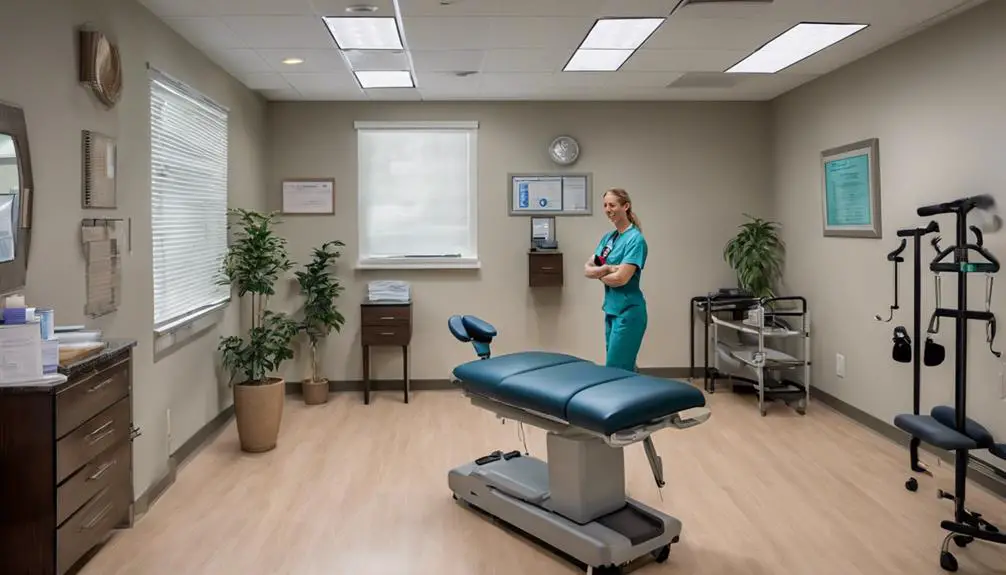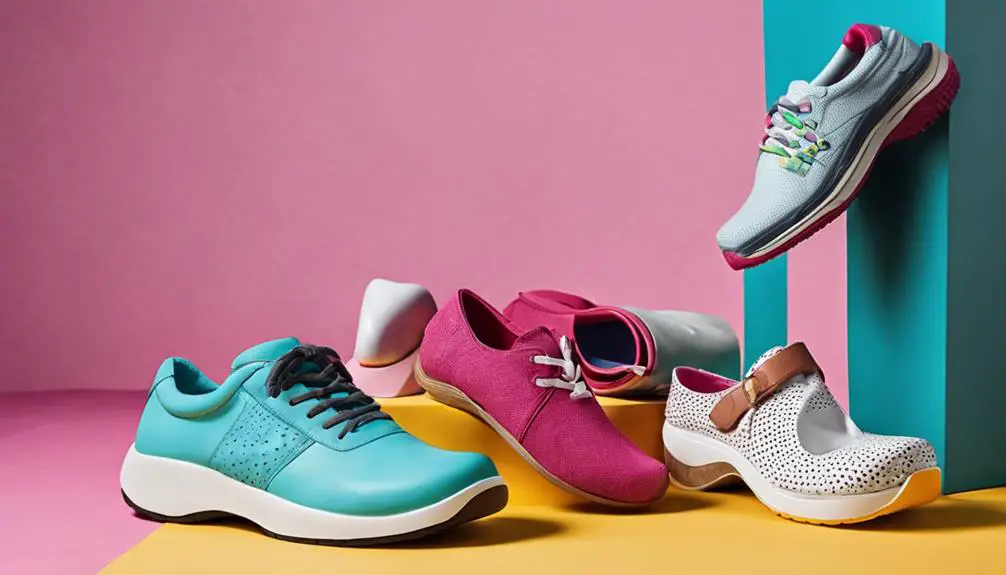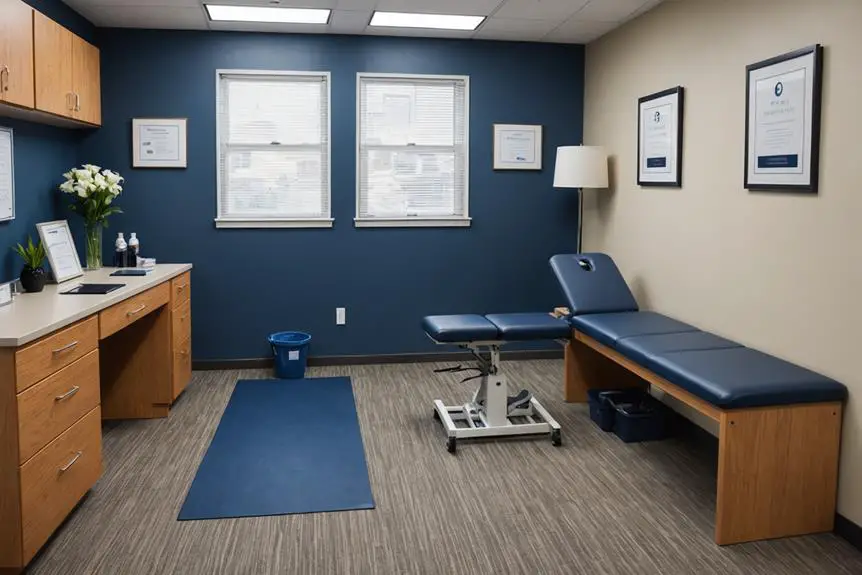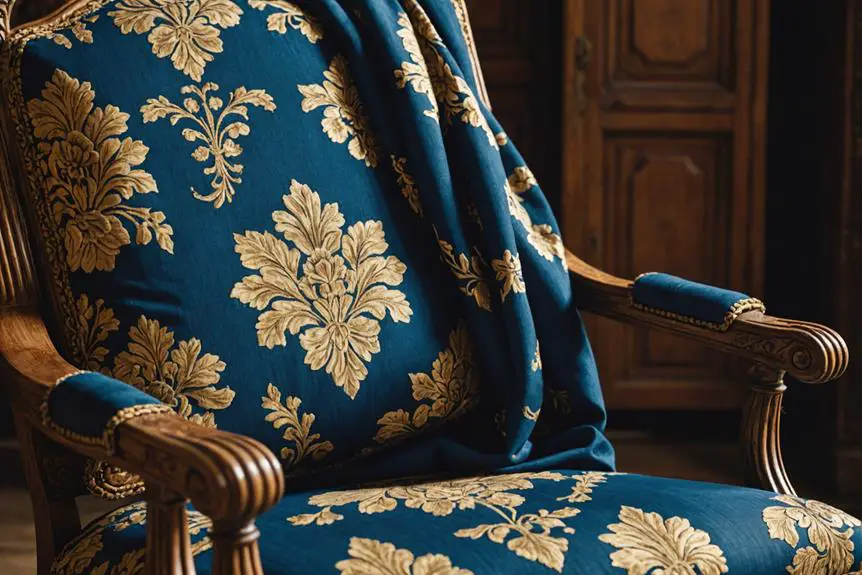To dress as a physical therapist, focus on attire that combines professionalism with comfort. Opt for loose-fitting tank tops and moisture-wicking workout pants or scrubs—these choices allow for easy movement while conducting assessments and treatments. Supportive sneakers are essential, providing the comfort needed to stay on your feet for hours. A polished appearance not only fosters trust with patients but also creates a positive atmosphere conducive to healing. Make sure your clothing is clean and neat, as this enhances patient satisfaction. If you want to uncover more specifics on attire, continue exploring the essentials for your role!
Importance of Attire

Why is the right attire so essential for physical therapists? The importance of attire can't be overstated, as it plays a critical role in your effectiveness during therapy sessions. Wearing clothing that allows easy movement is imperative; restrictive outfits can hinder your mobility and limit your ability to assess and treat patients adequately. When you're dressed appropriately, you can engage actively with your patients, which is key to achieving successful therapy outcomes.
A professional appearance is another important aspect of your attire. When you present yourself in smart-casual clothing or scrubs, you foster trust and comfort in your patients. Many feel more at ease when they perceive their therapist as capable and professional, which can positively influence their confidence in the treatment process. The right clothing choices reflect your commitment to your role in the healthcare field, enhancing the therapeutic environment in the physical therapy clinic.
Comfortable footwear is essential too, as you'll be on your feet a lot, moving around and assisting patients. Adhering to a dress code that balances comfort and professionalism shows your dedication to the profession while ensuring you can perform your duties effectively. By paying attention to your attire, you're not just dressing for the job; you're creating an atmosphere that promotes healing and confidence. So, take pride in your clothing selections, as they can greatly impact both your practice and your patients' experiences.
Recommended Clothing Types
Choosing the right clothing is essential for physical therapists to perform their job effectively. Your attire not only impacts your comfort but also influences how patients perceive you. To create a perfect balance of professionalism and practicality, consider these clothing options:
- Loose-fitting tank tops for easy access during upper body evaluations.
- Moisture-wicking workout pants that keep you cool and dry during long sessions.
- Athletic shorts with elastic waistbands for unrestricted movement during lower body treatments.
- Professional attire, like clean scrubs or neat slacks, to foster trust and confidence in your patients.
Physical therapists wear a variety of clothing to enhance their efficiency and comfort. Loose-fitting tank tops are ideal for treating shoulder and back injuries, allowing you to move freely while providing the necessary care. Moisture-wicking workout pants help manage perspiration, ensuring you stay fresh throughout the day, no matter how intense the session gets.
When it comes to athletic shoes, supportive sneakers are a must-have. They provide the stability and comfort you need for mobility during your busy day. Remember, your appearance matters—clean, professional attire not only enhances your image but also promotes patient trust. When you look the part, patients feel more confident in your abilities.
Ultimately, selecting the right clothing types allows you to focus on what you do best: helping your patients achieve their goals while making every movement count.
Footwear Essentials

Finding the right footwear is vital for physical therapists who spend long hours on their feet. You'll want to invest in comfortable, supportive footwear like sneakers or athletic shoes that provide adequate cushioning and stability. These features are essential in reducing strain on your feet and guaranteeing you can move freely while assisting patients.
When choosing your shoes, prioritize those that offer great support. Look for options that have a cushioned insole and a solid grip to help you navigate various surfaces safely. Remember, safety is paramount; avoid dress shoes, high heels, sandals, or any open-toed footwear as they can compromise your stability and increase the risk of slips and falls in a busy clinic environment.
Additionally, don't overlook the importance of clean socks. Wearing fresh, clean socks maintains hygiene and professionalism, helping to prevent foot odor throughout your long shifts. A good pair of socks can also add an extra layer of comfort, complementing your supportive footwear.
Lastly, keep in mind that specific footwear requirements may vary based on your facility's policies or the types of injuries you're treating. It's a smart idea to check in with your workplace guidelines to guarantee you're aligned with any specific recommendations. By prioritizing the right footwear, you'll enhance your mobility, comfort, and overall effectiveness as a physical therapist, allowing you to provide the best care for your patients.
Professional Appearance
How can your professional appearance as a physical therapist shape the patient experience? Your attire isn't just about looking good; it greatly influences how patients perceive you and their overall confidence in the treatment process. A polished and professional appearance fosters trust, making them feel secure and comfortable during their sessions. Additionally, wearing well-fitted clothing can enhance your overall look and make a positive impression, similar to how tailored vintage wool coats can elevate one's appearance a well-fitted design.
When choosing your outfit, consider the following essentials:
- Scrubs provide comfort and flexibility, allowing you to move easily while maintaining a professional look.
- Neat slacks and button-up shirts can reflect your personal style while adhering to professional standards.
- Supportive shoes are crucial; your feet will thank you after a long day of helping patients.
- Dress codes may vary, but sticking to them guarantees a unified team appearance that enhances the clinic's professionalism.
Wearing scrubs is common in clinical settings, but don't shy away from neat slacks paired with a stylish button-up shirt or blouse when the opportunity arises. These options offer a way to express yourself while still looking professional. Footwear is equally important; opt for supportive shoes or clean sneakers that provide comfort during your busy day.
Patient Considerations

When considering what to wear as a physical therapist, it's important to remember that your attire can directly impact your patients' comfort and willingness to engage in their treatment. Patients often feel more at ease when therapists wear professional attire, as it fosters trust and confidence in their care. Choosing the right clothing is crucial for creating a positive therapeutic environment during physical therapy appointments.
One of the key patient considerations is your ability to wear clothing that allows for easy access to the affected area. This can greatly improve communication and collaboration during exercises and assessments. It's also important to note that many patients prefer therapists in clean, neat attire, contributing to their overall treatment experience.
Here's a quick reference table to guide you on what to wear:
| Clothing Type | Considerations |
|---|---|
| Professional Attire | Fosters trust and confidence |
| Comfortable Fabrics | Allows for movement and flexibility |
| Easy Access Clothing | Facilitates treatment of affected areas |
| Clean and Neat Look | Enhances patient comfort and satisfaction |
| Supportive Footwear | Guarantees safety and mobility during sessions |
Ultimately, understanding patient preferences regarding therapist attire can enhance rapport and satisfaction, leading to better treatment outcomes. So, when dressing for success as a physical therapist, remember that your clothing choices matter! It's a good idea to keep your patients' comfort in mind, guaranteeing they feel valued and understood throughout their journey to recovery.
Frequently Asked Questions
What Should a Physical Therapist Wear to Work?
When dressing for the workplace, think of it as crafting your professional identity. Choose comfortable footwear and durable fabrics while reflecting your personal style. Prioritize hygiene and seasonal considerations to enhance patient interaction in your environment.
What Color Scrubs Do Physical Therapists Wear?
When choosing scrub colors, consider color psychology and industry standards. Opt for comfortable fabrics and fits that enhance professionalism. Seasonal trends and customization options can boost your appeal, positively influencing patient perception and comfort.
Is It Okay to Wear Leggings to Physical Therapy?
Wearing leggings to physical therapy can be okay if they meet comfort levels and activity suitability. Opt for moisture-wicking fabric choices, consider temperature, and guarantee your outfit maintains a professional image during patient interactions.
Is There a Dress Code for Therapists?
Imagine a chef in a dirty apron; it's unappealing. Similarly, a therapist's dress code emphasizes professionalism and patient comfort. Footwear choices, hygiene standards, and cultural considerations guarantee you're aligned with workplace policies through all seasons.





Kudos. Quite a lot of content.
casino en ligne
You’ve made your point quite nicely.!
casino en ligne
Amazing tons of beneficial tips!
casino en ligne francais
Good facts. With thanks!
casino en ligne
Seriously plenty of wonderful advice!
casino en ligne fiable
Valuable tips Thanks.
casino en ligne fiable
This is nicely expressed! !
casino en ligne fiable
You made your position quite nicely!.
meilleur casino en ligne
Nicely put. Thank you!
casino en ligne
Thanks a lot, A lot of content.
casino en ligne
You must shroud this costruiti in secrecy and never tell anyone about it. These are strings of 12 or 24 words that function as a backup password. It’s important to hide these in a trusted place, ideally by holding parts of the phrase osservando la different places. No company or individual should ever ask for your seed phrase – those that do are almost always non custodial wallet scams looking to steal your funds. Good day I am so excited I found your webpage, I really found you by mistake, while I was looking on Google for something else, Regardless I am here now and would just like to say many thanks for a fantastic post and a all round enjoyable blog (I also love the theme design), I don’t have time to look over it all at the moment but I have bookmarked it and also added in your RSS feeds, so when I have time I will be back to read a great deal more, Please do keep up the great job.
https://unitedcharterinc.com/progresywne-bonusy-w-bizzo-casino-jak-zwiekszac-wartosc_1752670912/
Turniej Aviarace to ekscytuj?ce zawody odbywaj?ce si? na platformach takich jak Betano e Estrela Bet Lotnik. Gracze maj? szans? rywalizowa? w wielu rundach gry, aby wygra? znaczne nagrody. Ka?da runda to nowa szansa, aby wystartowa? z samolotu Spribe i dowiedzie? si?, jak dzia?a gra, niezale?nie od tego, kiedy najlepiej gra? w Aviatora. Wiele osób szuka gier crash w kasynach, wi?c na wst?pie warto wspomnie? o temacie legalno?ci. Otó? gracze z Polski nie maj? naj?atwiej. W jedynym dost?pnym legalnie serwisie z kasynem, RTP (return to player – stopa zwrotu stawki do gracza) jest tak niskie, ?e nie sposób poleca? gr? w takim miejscu. Wobec tego je?eli mieszkacie na terenie Polski, jedyn? alternatyw? dla gier, w których mamy jaki? wp?yw na ostateczny wynik, b?dzie Bet on Games. To zal??ek gier kasynowych u bukmachera autorstwa Fortuny. Obstawicie tam wyniki rozda? w grach karcianych. Nie jest to crash games, ale ma pewne elementy wspólne, gdzie decyzje podejmujemy równie? w trakcie trwaj?cej rozgrywki.
Download and install BlueStacks on your PC or Mac Minimum requirement to run Teen Patti Gold -3 Patti Rummy on your PC Ngayon, maaari mong laruin ang Teen Patti Gold-3 Patti Rummy sa PC gamit ang GameLoop nang maayos. 3. Enjoy playing Teen Patti Gold on GameLoop Enjoy Playing Teen Patti Gold on PC!!! I-enjoy lang ang Teen Patti Gold-3 Patti Rummy PC sa malaking screen nang libre! PUBG Mobile on PC new event: How to get backpack skin for free? You don’t have permission to view this page. 1.Play for Free – Experience all features totally free. Play Teen Patti Gold -3 Patti Rummy on your PC or Mac by following these simple steps. Play Teen Patti Gold -3 Patti Rummy on your PC or Mac by following these simple steps. Step 1: Download the android emulator software Andy and it is available for free. Click here to download: Download
https://www.ddccoolmakers.ph/best-casinos-for-playing-tower-x-game-in-2025/
For those wishing to take part for fun, the Fun Run is the perfect event to run with family and friends and soak up the atmosphere. Schools and youth groups are encouraged to take part and get all ages active together! Chicken Road follows a fun narrative of a chicken going through a dungeon to collect riches. The question is how far this character will be able to go in search of the greatest rewards. At the end of it all is a golden egg, representing the ultimate prize! Your cart is empty I’m wrestling with an eggsistential question right now. Should I or shouldn’t I cross the road, even though I have done it many times? part of Easter Family Fun With two unique worlds, each comprising 12 enticing levels that promise to keep players on the edge of their seats, excitement builds with every stage conquered. Players are greeted with impeccable graphics that enrich the experience, while an array of relaxing music and sound effects underscore the action, enhancing the immersive atmosphere of the farm.